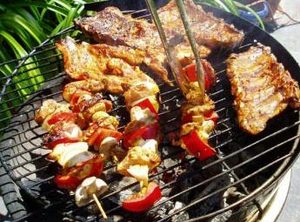1. The first barbecuers may well have been prehistoric cavemen. Anthropologists say they may have started roasting meat some 1.4 million years ago.Language development didn’t occur until 200,000 B.C. or later.Other sources say this originated in the Caribbean where the native Indians used wood gratings over a slow fire to cook strips of meat.
2. Lexington, North Carolina is known as the Barbecue Capital of the World. October is Barbecue Month there, with a month-long Annual Barbecue Festival. The city’s first barbecue restaurant opened in 1919; there are currently over 20 barbecue restaurants.
3. According to the Indiana Propane Company, the most common barbecue items (beside ribs) are: hamburgers, steaks, hot dogs, and chicken breasts.
4. 3 out of 4 American households own a grill and they use it on average of 5 times per month.
5. People in the Northeast U.S. are the heaviest barbecuers in the nation. The next most frequent barbecues are in the North Central region of the U.S., followed by the South and then the Western U.S.
6. The most popular holiday weekend for barbecuing is July 4th (surprise, surprise!), then Labor Day, with Memorial Day close behind.
7. The word “barbecue” may have come from the French phrase “barbe a queue” (from whiskers to tail-The term refers to the original method in which a whole animal was cooked on a spit over an open fire), or the Taino Indian word for their method of cooking fish over a pit of coals (barbacoa). Another source says that roast mutton in Romanian translates into “barbec.” So there are several accounts that vary on the true origins of the word. Barbecue is also known as “Barbeque”, “barbicue”, “barbique”, “Bar-B-Cue”, “Bar-B-Que”, “Bar-B-Q”, “BBQ”, “Cue”, and “Q”.
8. One of the greatest barbecue innovations is the creation of bread (from some 10,000 years ago) Actually, when you think about it, bread DOES complement the barbecue perfectly.
9. Ribs must be boiled prior to grilling, because putting them on the grill for the full cooking time will leave them dried out or burned. This pre-grill step can be done up to two days ahead.
10. Pineapples, bananas, peaches, nectarines, plums, mangos, pears, and papayas taste great grilled. Cut the fruit in half, remove the cores (or pits) and grill with the skin side up before turning over. Grilling caramelizes the natural sugars in fruit, creating a softer texture, richer flavor, and more concentrated aroma. Unlike vegetables, which are less delicate, fruit should be grilled over indirect heat to prevent overcooking.
11. Sweet or sugar-based sauces should only be brushed on at the end because the sugar in them tends to burn. But marnades made with vinegar, citrus oil, and yogurt can be brushed on grilled food throughout the cooking process.
12. The dark meat of the chicken is especially good for grilling due to the higher fat content, which keeps meat moist.
13. Slices of summer squash, zucchini, onions, mushrooms, and tomatoes can be grilled for an entree. Watch your vegetables closely-some only take minutes to cook.
14. You can baste fruit with coconut milk, lime juice, or orange juice to caramelize its natural sugars and enhance the flavor.
